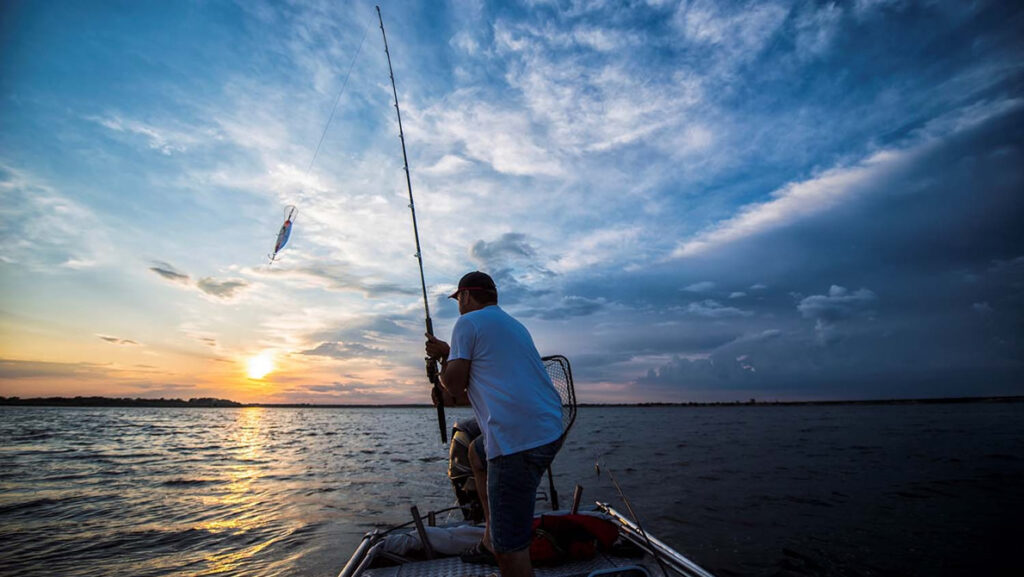Night fishing offers a unique angling experience compared to daytime fishing. Under the cover of darkness, big fish become more active and feeding patterns change. While night fishing can be productive, it also comes with its own set of challenges. This guide covers the top 5 tips to help you catch more fish after dark.
Why Fish at Night?
Several factors make night one of the best times to wet a line:
- Many gamefish species like bass, walleye, catfish, and trout feed more aggressively at night when prey is active. Their enhanced ability to hunt using lateral line sensitivity gives them an advantage after dark.
- Lower light levels make fish less easily spooked by noise and movement. Stealthy approaches become less important.
- Reduced fishing pressure at night means less competition for popular spots.
- For fishermen, cooler temperatures make night fishing more comfortable during summer.
- Working or family commitments often make night the only time to get in hours of prime fishing opportunity.
To capitalize after dark, adjust your fishing strategies using these night fishing tips:
1. Dial in Accurate Casting
Casting accuracy is still important at night, but becomes more challenging when you can’t see the target area well. Use these practices to cast more precisely after dark:
- Focus on familiar spots – Prior daylight scouting helps identify promising night hotspots.
- Use sound clues – Listen for baitfish activity to pinpoint fish zones.
- Watch the moon and stars – Use available light to faintly see structure.
- Up your leader size – A slightly thicker fluorocarbon leader can reduce costly snags.
- Use lures that make noise – Noisy crankbaits and topwaters allow following the lure.
- Cast then pause – Listen for subtle splashes indicating where your lure landed.
- Use casting mechanics – Smooth, flexible rods and tuned reels improve feel and control.
2. Light Up Your Fishing Area
One challenge of night fishing is not being able to see your fishing line, lures, or tackle. Proper lighting improves efficiency and safety.
- Headlamps – Hands-free headlamps let you see to tie knots and rig gear. Go for 500 lumens or more.
- Lanterns – Battery powered lanterns illuminate the entire boat or large shoreline area.
- Dock lights – Look for lit docks to orient yourself on the water.
- Glow sticks – Attach glow sticks to fishing line to see bites and position.
- Chest light – Chest mounted lights keep both hands free to fish.
- Boat lighting – LED boat lights attract fish and bait while providing visibility.
3. Use Visual Cues to Detect Bites
Without sunlight, visual bite detection becomes more difficult. Rely on these tips to spot bites:
- Glow bobbers – Floating bobbers with built-in lights help show subtle bites.
- Listen for line clicks – Keep an ear out for click and ticking sounds signaling pickups.
- Watch the line – Detect any unnatural line movement indicating a possible fish.
- Feel for vibrations – Fish tugging on the line transmits vibrations down the rod.
- Set the hook on anything unusual – Quickly strike at possible bites without waiting.
- Use circle hooks – Circle hooks catch fish on any hook set so strike fast.
4. Adjust Lure Colors and Styles
Fish respond to different lure colors, vibration frequencies, and styles in low light conditions:
- Dark colors – Black, purple, and dark green lures mimic baitfish silhouettes.
- Contrast colors – White bellies, chartreuse, and orange stand out in gloom.
- Metallics – Gold, copper, nickel, and silver reflect light.
- Noisemakers – Rattling crankbaits, poppers, and buzzbaits attract strikes.
- Big profiles – Upsize lures become easier for fish to find.
- Scented Soft Plastics – Garlic, shad, and crawfish scents appeal to fish senses.

foto: ioutdoor.com
5. Stay Safe and Comfortable
Remaining safe and comfortable through a long night session results in more fishing success:
- Tell someone your plans – Let family and friends know where you’ll be.
- Dress in layers – Bring sufficient cold weather clothing and rain protection.
- Watch navigation hazards – Avoid running aground or collisions after dark.
- Pack food and hydration – Hunger, thirst, and fatigue increase mistakes.
- Have proper boat lighting – Running lights, interior lights, and anchor lights are essential boating safety.
- Stay near the boat – Don’t wade too far away or take chances swimming at night.
- Know sunrise/set times – Arrive and depart with enough daylight visibility.
Night fishing opens up exciting opportunities to catch fish at times when others aren’t on the water. Making adjustments to tackle, techniques, and personal care will help you maximize your after dark fishing productivity and enjoyment.





